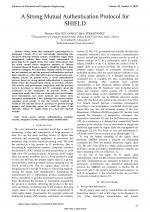| 4/2020 - 10 |
A Strong Mutual Authentication Protocol for SHIELDOZCANHAN, M. H. |
| Extra paper information in |
| Click to see author's profile in |
| Download PDF |
Author keywords
access control, authentication, computer security, integrated circuits, radiofrequency identification
References keywords
defense(11), supply(10), security(8), chain(8), rfid(7), systems(6), hardware(6), technology(5), office(5), counterfeit(5)
No common words between the references section and the paper title.
About this article
Date of Publication: 2020-11-30
Volume 20, Issue 4, Year 2020, On page(s): 81 - 90
ISSN: 1582-7445, e-ISSN: 1844-7600
Digital Object Identifier: 10.4316/AECE.2020.04010
Web of Science Accession Number: 000594393400010
SCOPUS ID: 85098217840
Abstract
Study shows that counterfeit semiconductors or Integrated Circuits (ICs) are increasingly penetrating into advanced electronic defense systems. Traditional supply chain management policies have been found unsuccessful in protecting the IC supply chain. Our study demonstrates that the newly started threat mitigation initiative of Defense Advanced Research Projects Agency's (DARPA) Supply Chain Hardware Integrity for Electronics Defense (SHIELD) scheme has not matured yet, and the proposed authentication protocol improvements are still vulnerable to known non-invasive, side-channel attacks. In present work, a novel authentication protocol based on strong mutual authentication is proposed, which resists the demonstrated attacks on previous schemes. The security and performance comparison with the previous work is provided, to inform the IC community about the seriousness of the weaknesses, in previous works. The comparison results show that our proposed protocol exchanges more information, uses more memory and makes more encryption computations. Thus, although our proposed scheme consumes more energy, it has the security required by SHIELD. The outcome forces IC producers to provide enough memory and processing power in a small die area, if the electronic defense IC supply chain is to have the expected security. |
| References | | | Cited By |
Web of Science® Times Cited: 2 [View]
View record in Web of Science® [View]
View Related Records® [View]
Updated 2 weeks, 4 days ago
SCOPUS® Times Cited: 2
View record in SCOPUS® [Free preview]
View citations in SCOPUS® [Free preview]
[1] Security Protocol Function Using Quantum Elliptic Curve Cryptography Algorithm, Sudharson, K., Arun, S., Intelligent Automation & Soft Computing, ISSN 1079-8587, Issue 3, Volume 34, 2022.
Digital Object Identifier: 10.32604/iasc.2022.026483 [CrossRef]
[2] Military Supply Chain Logistics and Dynamic Capabilities: A Literature Review and Synthesis, Loska, David, Hazen, Benjamin, Rich, Nicholas, Genchev, Stefan, Malik, Tegwen, Transportation Journal, ISSN 0041-1612, Issue 2, Volume 64, 2025.
Digital Object Identifier: 10.1002/tjo3.70002 [CrossRef]
Disclaimer: All information displayed above was retrieved by using remote connections to respective databases. For the best user experience, we update all data by using background processes, and use caches in order to reduce the load on the servers we retrieve the information from. As we have no control on the availability of the database servers and sometimes the Internet connectivity may be affected, we do not guarantee the information is correct or complete. For the most accurate data, please always consult the database sites directly. Some external links require authentication or an institutional subscription.
Web of Science® is a registered trademark of Clarivate Analytics, Scopus® is a registered trademark of Elsevier B.V., other product names, company names, brand names, trademarks and logos are the property of their respective owners.
Faculty of Electrical Engineering and Computer Science
Stefan cel Mare University of Suceava, Romania
All rights reserved: Advances in Electrical and Computer Engineering is a registered trademark of the Stefan cel Mare University of Suceava. No part of this publication may be reproduced, stored in a retrieval system, photocopied, recorded or archived, without the written permission from the Editor. When authors submit their papers for publication, they agree that the copyright for their article be transferred to the Faculty of Electrical Engineering and Computer Science, Stefan cel Mare University of Suceava, Romania, if and only if the articles are accepted for publication. The copyright covers the exclusive rights to reproduce and distribute the article, including reprints and translations.
Permission for other use: The copyright owner's consent does not extend to copying for general distribution, for promotion, for creating new works, or for resale. Specific written permission must be obtained from the Editor for such copying. Direct linking to files hosted on this website is strictly prohibited.
Disclaimer: Whilst every effort is made by the publishers and editorial board to see that no inaccurate or misleading data, opinions or statements appear in this journal, they wish to make it clear that all information and opinions formulated in the articles, as well as linguistic accuracy, are the sole responsibility of the author.



